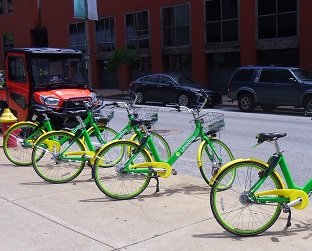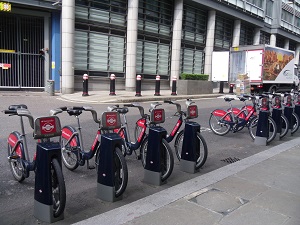Bicycle Sharing Continues to Advance
Last Updated: May 19, 2024
Bicycle sharing sounds like the most environmentally sustainable and frugal transportation solution imaginable. Just think of not having to own a car or a bike, but being able to find a cycle in cities, pedal one-way to where you need to be, and then pick up another bike or find a different mode of transportation to the next destination.
This idea has really mushroomed since we originally wrote about this topic. Cities worldwide quickly have made deals with private companies or began running the program themselves. Now it is common for large cities to have more than one company competing for business. Much of what we say here also applies to the more recent trend of shared electric (or non-electric) scooters, piggybacking on the same concept.
Since the big cities seem to have figured it out, we will aim this article also at small and medium sized cities that never would have considered such a program 10 or 15 years ago.

The advantages are no gasoline use, some healthy exercise in the case of bicycles but not electric scooters or bikes, and low cost per user because a resource, in this case a bicycle, is being shared.
Of course, tourists also benefit greatly, since they no longer have to use a car to bring a bike to their destination.
Despite the popularity of these programs for the last decade, especially in Europe but also in America and Asia too, in the early days most required a considerable government subsidy. Theft was a big issue, and despite the common practice of painting the participating units a particular bright color, those who want to disassemble the rental bikes to sell parts often succeeded.
However, technology has evolved a long way toward solving this problem. Companies and governments now are placing GPS units or other types of sensors on the bikes that allow them to be tracked, and culprits now can be caught and charged.
Dockless Bicycle Sharing: The Good and the Bad
Recently, this ubiquitous GPS tracking is giving operators the confidence to allow the bikes to be "dockless." This means that rather than having to borrow and return the bicycle from specific locations, riders can now pick them up anywhere they find them, unlock them with a credit or membership card, and leave them at their destination. In our opinion, the dockless business model has caused this business to grow exponentially. The docking devices were expensive in and of themselves, so eliminating the docking stations both increases demand and reduces capital needed for entry into a market.
The "elephant in the room" with dockless services is the haphazard drop off system. In our photo at the beginning of the article, a business district has neatly lined up the bikes for rent. However, in the real world, we also see the bicycles left at every angle across the sidewalk in our community. Just last week we saw an entire sidewalk blocked by three shareable dockless bicycles. This is an obvious inconvenience and possible hazard to pedestrians.
But just think what happens when the inexperienced user parks the bicycle close to the curb and it is knocked over into the parking lane or even the driving lane. Buses and taxis already are complaining about where the bicycles are left in dockless cities. A few bicycles no doubt will disappear into a river or over a cliff when someone parks the dockless bike too close to the edge.
Shared Bike Policy Goals for City Governments to Consider

From the standpoint of governments that must either operate or license programs, the question of which policy goals you want to address really deserve careful consideration. Recently I worked with a city on just this question. Possibilities include:
- Lowering air pollution and greenhouse gas emissions from cars
- Devising an inexpensive, convenient, and fun transportation option for tourists
- Reducing peak hour congestion for commuting to work or school, thereby making it possible to squeak by for a few more years without widening roads
- Reducing or eliminating a household's capital investment in owning personal transportation
- Wishing to add to the character of a city that is bicycle-friendly and would like to cultivate even more riders
- Needing university students to travel from one side of campus to the other in 10 minutes or less
- Experimenting with a longer-term conversion of more automobile drivers to cyclists
- Needing to help people move as much as possible as a public health priority
- Providing green jobs or a green business opportunity
- Helping young teens move about the city to go to parks, their soccer games, the library, or to a transit stop
- Adding to the coolness factor of an otherwise staid city or a town that considers itself too small to offer big-city appeal to younger people.
Quick Review of the Evolution of Bicycle Sharing Programs
The first bike share program that people seem to remember is the Amsterdam white bikes in the late 1960s. I think this was more of a project or social experiment than a serious attempt to alter the transportation system. It didn’t last long; when the cycles are all stolen, that tends to halt everything.
There have been scattered other attempts, but almost everything operating now has started within the last few years. The largest known system is in Beijing, China, where there are about 2.5 million bicycles in the system. By contrast, Paris has 20,000 in the Velib program in its second attempt at getting this right, but Paris is ahead of New York and London in this regard.
The bicycle sharing idea is growing so fast that we won't be giving any more statistics or listing any more cities. In fact, the four of us who work on this site know of five programs that aren't listed in Wikipedia. (The pace of change means that we aren't going to spend our time updating it either. Call us lazy if you want.)
Many colleges and large businesses now administer their own programs. On college or business campuses, sometimes the bicycles are not supposed to go beyond a defined perimeter.
Also the concept of bicycle libraries has emerged, with public library systems actually taking a look at extending their rentals to bicycles. Sometimes six months is mentioned as the amount of time appropriate for checking out a bike. This solution often is considered the right one for lower-income populations where cycle maintenance costs are a problem.
Recently some private companies are offering a low-income membership that allows up to a particular number of rides for a set low fee.
The systems tend to work on one of two principles, either a smart card activation or cell phone activation. Most systems now use an app to allow potential users to find the bike and perhaps reserve it. Many places now require a membership fee. Sometimes a credit card is required to obtain the membership.
Why This Approach Isn't as Easy as It Looks
Pretend you're a tourist, you used bicycle sharing to go to the zoo, and now you're ready to go back to the hotel, but there's no bike in sight. You get on your smartphone and find out that state of affairs isn't predicted to change any time soon.
Now you begin to see why this apparently simple idea isn't as easy as it looks. If a resident uses a sharing membership to get a bicycle to go to work every day, that becomes a routine. Others may face a learning curve that just isn't worthwhile.
That's why we say on this website that your program design must be very clear about which social, economic, and/or environmental goals you’re trying to maximize before you start. A lively discussion with the public, which easily could be conducted through social media and website polling, is suggested.
As an example of why we are emphasizing the goal-setting so heavily, consider that most of the programs we've seen seem inherently easier to use for the locals than for tourists. This is true because of fairly intricate rules, annual memberships, and sometimes a less than obvious list of bicycle sharing companies or apps from which to choose.
Tourists and poor people seem to be the people who would be most grateful for the ability to have what amounts to bike rental.
As we imply already by talking about green entrepreneurship, it's possible that a small private company or a community-controlled cooperative could run bicycle sharing in your community. However, the technology and ways to address operational hazards probably need to become even more reliable for this to be a truly self-sustaining activity. In the meantime, a smaller city may choose to subsidize this service, which will serve several positive social and community development goals.
If you investigate and find that bicycle sharing isn't practical in your community, just concentrate on making yourselves a
bikeable community until better technology and inventive business models make it more feasible.
The multiple potential benefits to the environment from reducing traffic congestion, vehicle miles traveled, and possibly even vehicle lanes needed surely justify your effort.
From a community development standpoint, you’re going to have many more conversations on a bicycle than in a vehicle. The slower pace makes noticing and interacting with the built environment, in both its positive and negative aspects, much easier. If the private market hasn't provided bicycle sharing already, it could be time for local government to recruit such a company, marketing them on the basis of the denser parts of our communities.
Larger, more trendy cities will need to think broadly about the innovative transportation ventures, even beyond bicycle sharing, that are likely to be moving into their territory any time now. For example, see a good summary of how cities had to respond fast to dockless electric scooter sharing. Also related for some of you may be our new page on how autonomous vehicles will change city planning and community development.
For More Reading on sustainable Cities
- Making and Keeping a Good Community >
- Community Improvement Projects > Bicycle Sharing
Join GOOD COMMUNITY PLUS, which provides you monthly with short features or tips about timely topics for neighborhoods, towns and cities, community organizations, and rural or small town environments. Unsubscribe any time. Give it a try.



